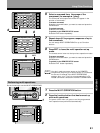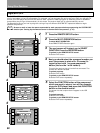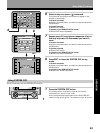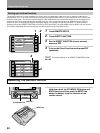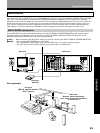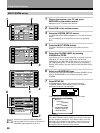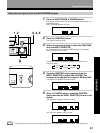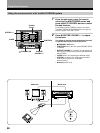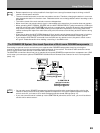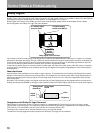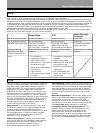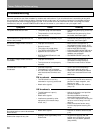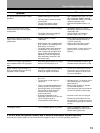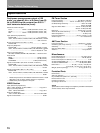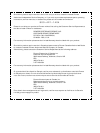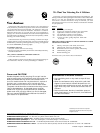
71
Techno Tidbits & Problem-solving
DTS
DTS has been adopted as a sound recording format in the latest movie theaters since the release of “JURASSIC PARK” in
1993, and has a good reputation for high quality sound and dynamic surround effects.
In this system, 6 channels of digital sound are recorded on CD-ROM, rather than on the film. DTS adopts a simultaneous
playback format. With a low rate of compression of sound signals and a high rate of transmittance, a higher sound quality
format is produced. Also, unlike the process of recording digital sounds on film directly, the only components required are
a CD-ROM player as might be used with a personal computer and a DTS processor, and therefore less investment is
required than with other formats. For this reason, the format is being introduced in more and more movie theaters, and is
being adopted in home movie software (DVD, LD) and music software (5.1 channel CD).
More than 11,000 movie theaters around the world have adopted the DTS format, which is now the most popular digital
format for movie theaters, especially in U.S.A, Europe, and Asia.
No. of recorded channels
No. of playback channels
Playback channel structure
Sound processing
Rear (Surround) high
frequency playback limit
Other
Dolby Digital
5.1 channels (Max.)
5.1 channels (Max.)
Front Left, Front Right,
Center, Surround Left,
Surround Right, Sub Woofer
Digital discrete processing
20,000 Hz
• 5.1 completely
independent channels
• High dynamic range
• Stable position, high phase
characteristics, and
advanced surround effects
reproduction
• High efficiency
(Compression rate of about
one-tenth)
Dolby Pro Logic
Surround
2 channels
4 channels
Front Left, Front Right,
Center, Surround
Analog matrix processing
7,000 Hz
DTS
6 channels (Max.)
6 channels (Max.)
Front Left, Front Right,
Center, Surround Left,
Surround Right, Sub Woofer
Digital discrete processing
20,000 Hz
• 6 completely independent
channels
• High dynamic range
• Stable position, high phase
characteristics, and
advanced surround effects
reproduction
• Low compression rate
(about one-fourth), high
quality sound
THX
THX is a Lucasfilm, Ltd. program dedicated to maximum
accuracy in movie presentation. Movie sound tracks are
recorded in large movie dubbing stages using movie
theater equipment. For a sound track to be presented
accurately in your home, special technologies are
required. In your home the room is much smaller and
has a bright sound, the speakers are very different and
there are only six of them, plus, you sit much closer to
each one of those speakers. Because of these differences
we often miss the power and emotion that thrills us in a
good movie. Now Pioneer and THX have teamed up to
bring the full glory of accurate cinema sound to the
comfort and convenience of your home.
Re-Equalization™ : In a theater the room is very large
and dead sounding, you sit a long way back from the
speakers and the speakers themselves are very
specialized. Because a sound track recorded in this dead
sounding space when it is played at home it sounds
overbright. THX Re-Equalization adjusts for this
difference in a very precise way.
Dynamic Decorrelation™ : When a sound track sends
mono sound to the surround speakers it often seems to
be coming come from one side instead of from all
around you as it would in a theater. Dynamic
Decorrelation helps to correct this inaccuracy.
Timbre Matching™ : When recording a sound track it is
very important that the surround sounds move smoothly
and seamlessly around the theater. It is very distracting
when sounds seem to jump from speaker to speaker.
Timbre Matching helps to smooth the movement of the
surround sounds even though you are using only two
speakers.
Bass Peak Level Manager™ : Some Dolby Digital sound
tracks can produce bass peaks that are undesirable in a
home theater environment. The Bass Peak Level
Manager allows you to set the maximum peak levels
appropriate to your system. (Set this function according
to the bass peak level instructions on page 30.)
Loudspeaker Position Time Synchronization™ : This
feature allows you to adjust for the difference in the
distance from each individual loudspeaker to the
listening position. Doing this ensures that all the
speakers operate in precise synchronization improving
the seamless nature of the soundfield. (Set this function
according to the channel delay instructions on page
26.)



